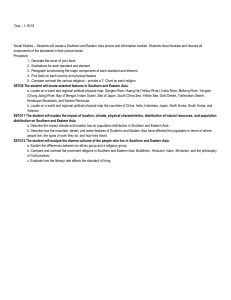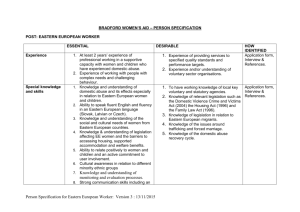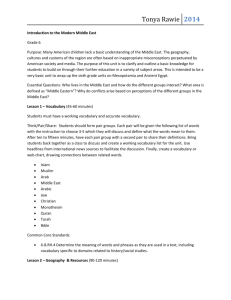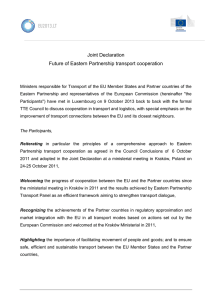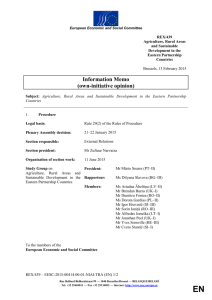The Standards & Elements of
advertisement
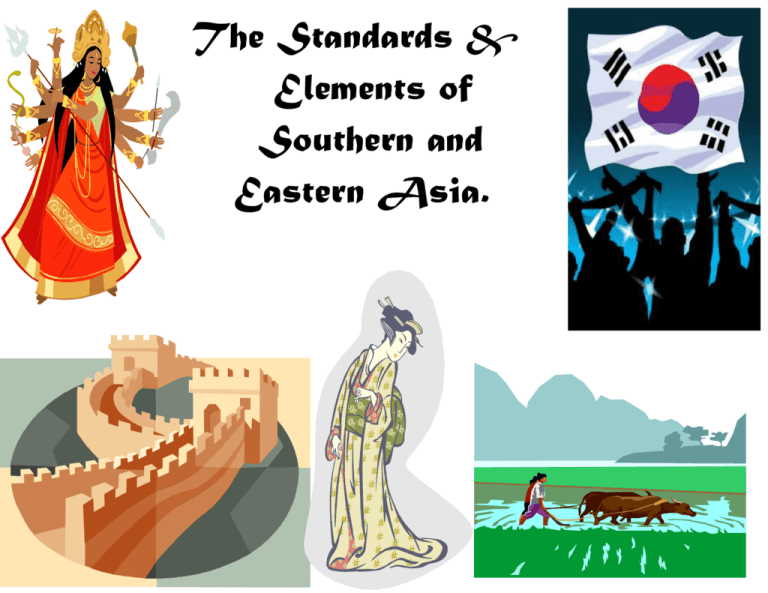
The Standards & Elements of Southern and Eastern Asia. The Physical/Political Geography of Southern & Eastern Asia (1) SS7G9: The student will locate selected features in Southern & Eastern Asia. a. Locate on a world and regional political-physical map: Ganges River, Huang He (Yellow River), Indus River, Mekong River, Yangtze River (Chang Jiang), Bay of Bengal, Indian Ocean, Sea of Japan, South China Sea, Yellow Sea, Gobi Desert, Taklimakan Desert, Himalayan Mountains, and Korean Peninsula. b. Locate on a world and regional political-physical map the countries of China, India, Indonesia, Japan, North Korea, South Korea, and Vietnam. On the map locate the following features: Rivers Ganges River Huange He (Yellow River) Indus River Mekong River Yangtze River (Chang Jiang) Bay/Sea/Oceans Bay of Bengal Indian Ocean Sea of Japan South China Sea Yellow Sea Landforms Gobi Desert Taklimakan Desert Himalayan Mountains Korean Peninsula The Physical/Political Geography of Southern & Eastern Asia (2) Identify the following countries, and color them according their type of government China India Indonesia Japan North Korea South Korea Vietnam Monarchy-Green Democracy-Blue Communist-Red Environmental Issues of Southern & Eastern Asia (1) SS7G10: The student will discuss environmental issues across Southern & Eastern Asia a. Describe the cause and Effects of pollution on the Yangtze (Chang Jiang) and Ganges Rivers. b. Describe the Cause and Effects of air pollution and flooding in India and China. The Environment China India Water quality issues Causes of Air pollution Causes of pollution Effects of air pollution and flooding. Effects of water pollution Yangtze (Chang Jiang) Ganges Environmental Issues of Southern & Eastern Asia (2) SS7G11: The student will explain the impact of location, climate, physical characteristics, distribution of natural resources and population distribution on Southern & Eastern Asia. a. Describe the impact climate and location has on population distribution in Southern & Eastern Asia. b. Describe how the mountain, desert, and water features of Southern & Eastern Asia have affected the population in terms of where people live, the types of work they do, and how they travel. Impact of Location Where people live? Type of work they do? How they travel? Mountains Deserts Water Features Culture & Religion in Southern & Eastern Asia SS7G12: The student will analyze the diverse cultures of the people who live in Southern & Eastern Asia. a. Explain the differences between and ethnic group and a religious group. b. Compare and contrast the prominent religions in Southern & Eastern Asia: Buddhism, Hinduism, Islam, Shintoism, and the philosophy of Confucianism. (notes to be given) c. Evaluate how literacy rate affects the standard of living. Examples of ethnic groups in S&E Asia are: Why is literacy so important to standard of living? Governments of Southern & Eastern Asia (1) SS7CG6: The student will compare and contrast various forms of government. a. Describe the ways government systems distribute power: Unitary, Confederation, and Federal. b. Autocratic Democratic Role of the citizen b. Explain how governments determine citizen participation: autocratic, c. oligarchic, and democratic. Role of Leadership c. Describe two predominant forms of Legislature democratic government: parliamentary, and presidential. ________________ Oligarchic __________________ Parliamentary Presidential ________________ Governments of Southern & Eastern Asia (2) SS7CG7: The student will demonstrate an understanding of national governments in Sothern & Eastern Asia. a. Compare and contrast the federal republic of the Republic of India, the communist state of the People’s Republic of China, and the constitutional monarchy of Japan, distinguishing between the form of leadership, and the role of the citizen in terms of voting rights and personal freedoms. The Economic Systems of Asia (1) Economic Systems SS7E8: the student will analyze different economic systems. a. Compare how traditional, command, and market economies answer the questions of: What to produce How to produce For whom to produce b. Explain how most countries have a mixed economy located on a continuum between pure market and pure command. c. Compare and contrast the economic systems in China, India, Japan, and North Korea. ---------------------------------------------------------- Pure Command China Economic Questions Traditional Command Market What to produce? How to produce? Pure Market ---------------------------------------------------------- Pure Command India Pure Market ---------------------------------------------------------- Pure Command Japan Pure Market ---------------------------------------------------------- Pure Command North Korea Pure Market For whom to produce? b. Mixed is a ____________________ of two economic systems. Trade Systems in Asia (2) SS7E9: The student will explain how voluntary trade benefits buyers & sellers in Southern & Eastern Asia. a. Explain how specialization encourages trade between countries. b. Compare and contrast different types of trade barriers, such as: Tariffs Quotas Embargos c. Explain why international trade requires a system for exchanging currencies between nations. How does specialization encourage trade between nations? ______________________________________ ______________________________________ b. Controls on free trade A tariff is… A quota is… An embargo is… How does global trade require a system for exchanging currency? ______________________________________ ______________________________________ ______________________________________ ______________________________________ ______________________________________ Economic factors of Production in Asia (3) SS7E10: The student will describe factors that influence economic growth and examine their presence/absence in India, China, and Japan. a. Explain the relationship between investment in human capital (education & training), and gross domestic product (GDP) b. Explain the relationship between investment in capital (factories, machinery, and technology) and GDP. c. Describe the role of natural resources in a country’s economy. d. Describe the role of entrepreneurship. (in a country’s economy) The four factors that influence a country’s economic growth are: 1. ______________________________________ 2. ______________________________________ 3. ______________________________________ 4. ______________________________________ Gross Domestic Product (in my own words)is: ________________________________________ ________________________________________ ________________________________________ ________________________________________ Examples of investment in Human capital are: ________________________________________ ________________________________________ ________________________________________ Examples of investment in CAPITAL are: ________________________________________ ________________________________________ ________________________________________ If I could be an entrepreneur I would: ________________________________________ ________________________________________ History of Southern & Eastern Asia SS7H3: The student will analyze continuity and change in Southern and Eastern Asia leading to the 21st century. a. Describe how nationalism led to independence in Vietnam, and India. b. Describe the impact of Mohandas Gandhi’s belief in non-violent protest c. Explain the role of the United States in the rebuilding of Japan after WWII d. Describe the impact of communism in China in terms of Mao Zedong, The Great Leap Forward, The Cultural Revolution, and Tiananmen Square. e. Explain the reasons for foreign involvement in Korea and Vietnam in terms of containment of Communism. ____________________________________ ____________________________________ ____________________________________ ____________________________________ ____________________________________ ____________________________________ ____________________________________ ____________________________________ ____________________________________ ____________________________________ ____________________________________ ____________________________________ ____________________________________ ____________________________________ ____________________________________ ____________________________________ ____________________________________ ____________________________________ ____________________________________ ____________________________________ ____________________________________ ____________________________________ ____________________________________ ___________________________________
